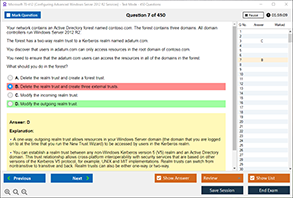Overview of the CompTIA 220-1101 Exam
The CompTIA A+ 220-1101 exam is a core certification test for aspiring IT professionals, covering essential topics such as mobile devices, networking technology, hardware, virtualization, and cloud computing. As part of the A+ Core Series, this exam is designed to validate a candidate's ability to support and troubleshoot devices and infrastructure. One of the hardware topics covered includes memory modules like DDR5 DIMMs. Understanding the features, capacity, and evolution of memory types is crucial for success on this exam.
DumpsBoss is a trusted platform that offers expert-verified study materials, real exam dumps, and detailed explanations tailored to the CompTIA 220-1101 exam objectives. With DumpsBoss, candidates can prepare more efficiently and master complex hardware concepts like DDR5 memory with ease.
What is DDR5 Memory?
DDR5, or Double Data Rate 5, is the fifth generation of DRAM (Dynamic Random Access Memory). It is the successor to DDR4 and introduces significant enhancements in performance, capacity, and power efficiency. Released commercially in 2020, DDR5 is designed to meet the growing demands of high-performance computing, gaming, and data-intensive applications.
DDR5 memory offers a substantial increase in bandwidth and reduced power consumption compared to previous generations. It is particularly useful in systems requiring high multitasking capabilities and is becoming increasingly relevant in modern PCs, servers, and mobile devices. Understanding DDR5 is essential for any IT technician preparing for the CompTIA 220-1101 exam.
Key Features of DDR5 DIMM Modules
DDR5 DIMM (Dual Inline Memory Module) modules are engineered to deliver better efficiency, performance, and scalability. Here are some of the key features:
-
Higher Bandwidth: DDR5 can achieve data rates of up to 8400 MT/s (Mega Transfers per second), significantly faster than DDR4's 3200 MT/s.
-
Increased Capacity: Each DDR5 DIMM can support higher memory capacities, allowing for more extensive system memory.
-
Improved Power Efficiency: DDR5 operates at a lower voltage (1.1V compared to DDR4's 1.2V), which reduces power consumption and heat generation.
-
Dual-Channel Architecture: Each DIMM contains two 32-bit channels (non-ECC), improving data handling and parallelism.
-
On-Die ECC (Error Correction Code): DDR5 includes on-die ECC for improved reliability, especially beneficial in enterprise environments.
-
Better Scalability: DDR5 is designed to scale up as technology progresses, supporting higher memory demands in future computing environments.
These features make DDR5 a vital topic for anyone studying computer hardware and preparing for the CompTIA 220-1101 exam.
What is the Maximum Storage Capacity of a DDR5 DIMM?
One of the most impressive advancements in DDR5 memory is its potential maximum capacity. A single DDR5 DIMM module can theoretically support up to 512 GB of memory. This is a substantial increase compared to DDR4, where modules typically top out at 64 GB.
The higher capacity is made possible through improved die-stacking technology and advancements in DRAM architecture. In real-world consumer systems, however, common DDR5 DIMMs are currently available in 8 GB, 16 GB, 32 GB, and 64 GB variants. Server-grade and high-end workstation modules may push those limits even further.
For the CompTIA 220-1101 exam, understanding the potential maximum storage capacity is essential. It demonstrates a grasp of evolving hardware capabilities and prepares candidates for questions that test theoretical knowledge and real-world applications.
Why This Question Matters for the CompTIA 220-1101 Exam
Understanding DDR5 memory and its storage capacity is directly aligned with the hardware objectives of the 220-1101 exam. Here’s why this question matters:
-
Exam Relevance: Hardware topics like memory types, capacities, and specifications are a core focus of the 220-1101 exam. Questions may test your ability to distinguish between DDR4 and DDR5 or identify maximum capacities.
-
Practical Troubleshooting: IT professionals must understand memory capabilities to install, upgrade, and troubleshoot systems efficiently.
-
Future-Proofing Knowledge: As DDR5 adoption increases, having an up-to-date understanding of memory technology makes candidates more competitive in the job market.
-
Informed Decision-Making: Professionals need to recommend suitable hardware solutions based on system requirements. Knowing memory limits helps make accurate recommendations.
DumpsBoss ensures candidates are well-prepared for these kinds of questions with updated content and comprehensive exam resources.
Comparison: DDR4 vs. DDR5 Capacity
| Feature | DDR4 | DDR5 |
|---|---|---|
| Max DIMM Capacity | Up to 64 GB | Up to 512 GB |
| Typical Consumer Size | 4 GB to 32 GB | 8 GB to 64 GB |
| Voltage | 1.2V | 1.1V |
| Data Rate | Up to 3200 MT/s | Up to 8400 MT/s |
| ECC | Only in ECC Modules | On-die ECC for all DIMMs |
| Channels per DIMM | Single 64-bit | Dual 32-bit (non-ECC) |
This comparison highlights the significant leap in performance and capacity from DDR4 to DDR5. These differences are crucial for CompTIA exam candidates to understand, as questions may test the ability to compare memory specifications and recommend appropriate configurations.
Common Misconceptions
There are several misconceptions surrounding DDR5 memory and its implementation. Clarifying these can help avoid confusion during the exam:
-
"DDR5 is Only for Gaming PCs": While DDR5 is beneficial for gamers, it is also crucial for data centers, servers, and high-performance workstations.
-
"All DDR5 Modules Support 512 GB": Although the theoretical limit is 512 GB, most consumer modules currently range between 8 GB and 64 GB.
-
"DDR5 Isn't Widely Available Yet": As of 2024, DDR5 has become increasingly mainstream, especially with support from Intel's 12th/13th Gen and AMD's Ryzen 7000 processors.
-
"DDR5 Replaces the Need for ECC RAM": DDR5's on-die ECC improves reliability, but it doesn’t replace the full functionality of server-grade ECC RAM used for mission-critical systems.
-
"You Can Mix DDR4 and DDR5": These two memory types are not compatible and cannot be mixed due to different voltages, pin configurations, and memory controllers.
Understanding and debunking these myths helps candidates stay informed and confident when answering exam questions or addressing real-world scenarios.
Conclusion
As memory technology evolves, understanding DDR5 becomes essential for IT professionals. The CompTIA 220-1101 exam tests foundational knowledge in hardware, and memory specifications like those of DDR5 DIMMs are a critical component. Knowing the maximum storage capacity—up to 512 GB—as well as key differences between DDR4 and DDR5 can make a significant difference in exam performance.
For aspiring technicians, grasping these concepts isn't just about passing an exam; it also builds the technical foundation necessary for real-world problem-solving and system optimization.
DumpsBoss provides the best resources for mastering topics like DDR5. With expertly curated exam dumps, practice tests, and guides tailored to the 220-1101 exam, DumpsBoss ensures that candidates are fully equipped to tackle memory-related questions and more. By leveraging DumpsBoss, exam-takers can boost their confidence, reduce study time, and increase their chances of certification success.
In conclusion, a deep understanding of DDR5 memory—including its features, capacity, and practical implications—is indispensable for both the CompTIA 220-1101 exam and a thriving IT career. And with DumpsBoss as your study companion, success is just a few practice questions away.
Special Discount: Offer Valid For Limited Time “CompTIA 220-1101 Dumps” Order Now!
Sample Questions for CompTIA 220-1101 Exam Dumps
Actual exam question from CompTIA 220-1101 Exam.
What is the maximum storage capacity of a single DDR5 DIMM stick?
A) 64 GB
B) 128 GB
C) 256 GB
D) 512 GB



